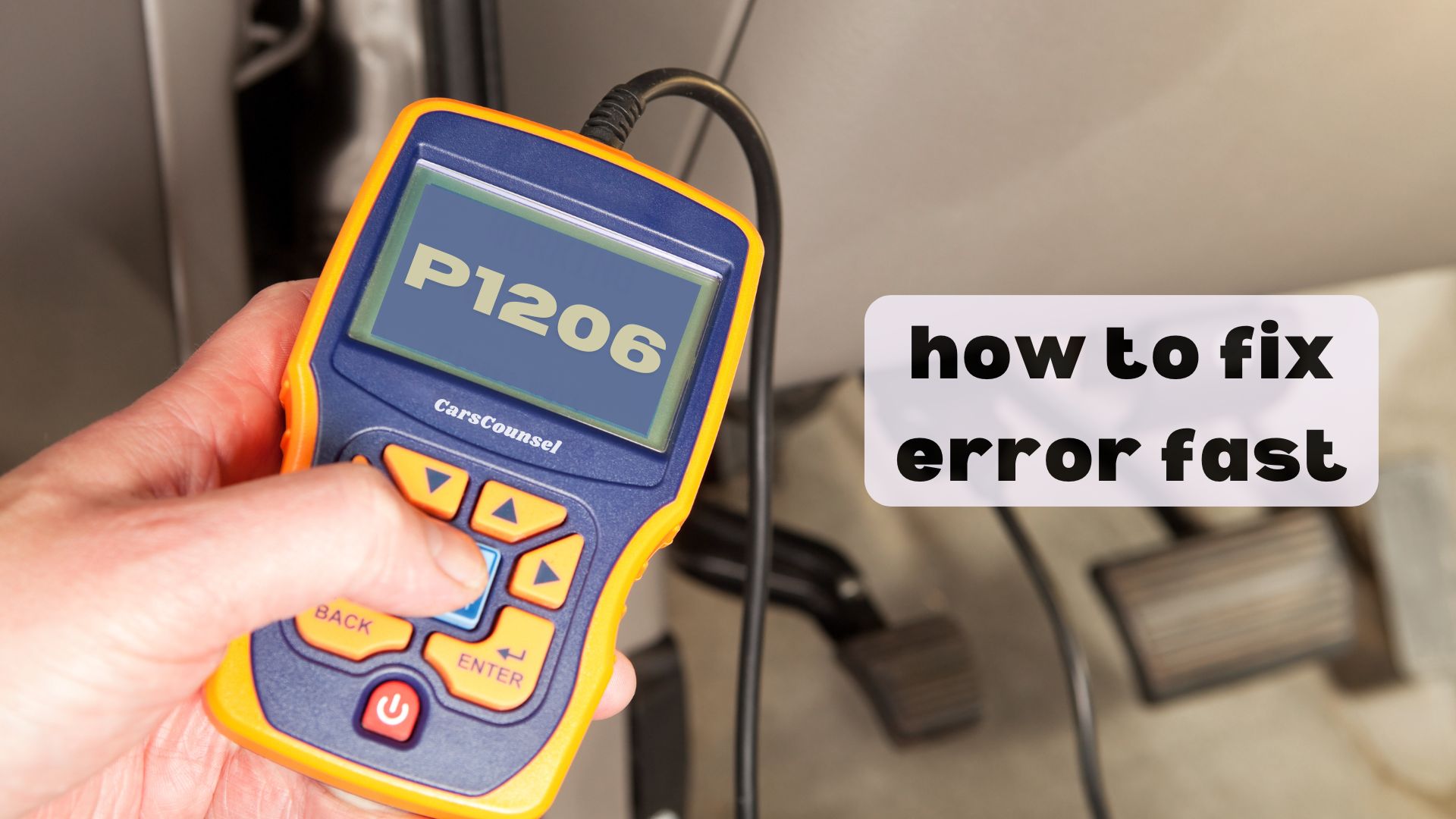When your car’s onboard computer spits out a P1206 code, it’s telling you that a fuel system failure is causing a misfire in the No. 6 cylinder. This can lead to poor engine performance, decreased fuel efficiency, and potential damage if left unresolved. You’ll want to get to the bottom of this issue ASAP, as it could be caused by anything from a simple fuel system leak to a faulty sensor or clogged fuel injector. What’s behind the malfunction, and how can you fix it?

Quick Navigation
Key Takeaways
- The P1206 code indicates a fuel system failure causing a misfire in the No. 6 cylinder, leading to poor engine performance and decreased fuel efficiency.
- Common culprits include fuel system leaks, faulty sensor readings, clogged fuel injectors, and malfunctioning fuel pumps or regulators.
- Symptoms include engine hesitation, loss of power, stalling, rough idling, and decreased fuel efficiency and engine performance.
- Diagnosing the misfire involves connecting a scan tool, performing a visual inspection, and monitoring engine performance and sensor data in real-time.
- Fixing the P1206 code typically involves replacing faulty fuel system components, with costs ranging from $200 to $800, depending on the specific repairs needed.
Code P1206 Description
The diagnostic code P1206 indicates a fuel system failure causing a misfire in the No. 6 cylinder of the engine, which can lead to poor engine performance, decreased fuel efficiency, and potential damage to the engine if left unresolved.
You’re likely to experience a lack of power and rough running of the engine due to this issue.
To understand the root cause, it’s essential to have a fuel system overview.
This will help you identify the faulty component affecting engine performance optimization.
Common Causes of P1206
You’ve identified the P1206 code, which points to a fuel system failure causing a misfire in the No. 6 cylinder.
Now, it’s essential to determine the root cause of this issue. Common culprits include fuel system leaks, faulty sensor readings, and clogged fuel injectors.
Determining the root cause of the issue is essential, with common culprits including fuel system leaks, faulty sensor readings, and clogged fuel injectors.
Additionally, a malfunctioning fuel pump, faulty fuel pressure regulator, or problems with the fuel delivery system can also lead to this code.
Moreover, a faulty spark plug or ignition coil can contribute to the misfire.
Symptoms of P1206
When your engine is experiencing a P1206 code, it’s likely you’ll notice some telltale signs that something’s amiss.
You might feel a rough idling or shaking of the vehicle, which can be unsettling.
Here are three common symptoms to look out for:
- Engine hesitation: Your engine might stumble or hesitate when accelerating, making it difficult to maintain a steady speed.
- Loss of power or acceleration: You might notice a decrease in your vehicle’s overall performance, making it harder to merge onto highways or climb steep hills.
- Vehicle stalling: In severe cases, your vehicle might stall altogether, leaving you stranded on the side of the road.
How to Fix P1206
To fix the P1206 code, start by diagnosing the specific cause of the misfire in the No. 6 cylinder using a scan tool to read the engine codes and performing a fuel system inspection. This will help you identify the root cause of the issue, whether it’s a clogged fuel injector, faulty fuel pump, or fuel pressure regulator problem.
| Step | Action |
|---|---|
| 1 | Replace faulty fuel system components (injector, pump, regulator) |
| 2 | Check and replace spark plug and ignition coil if necessary |
| 3 | Clear engine codes and test drive the vehicle to verify the issue is resolved |
Diagnosing the Misfire
What’s causing the misfire in the No. 6 cylinder?
To diagnose the issue, you’ll need to use a scan tool to read the engine codes and perform a thorough engine inspection.
- Connect a scan tool to the vehicle’s onboard diagnostics (OBD) port to retrieve the trouble code and any related data.
- Perform a visual inspection of the engine, focusing on the fuel system components, such as the fuel injectors, fuel pump, and fuel pressure regulator.
- Use the scan tool to monitor engine performance and sensor data in real-time, helping you identify the root cause of the misfire.
Fuel Injector Issues
You’ve identified a misfire in the No. 6 cylinder, and now it’s time to investigate the fuel injector as a potential culprit. A faulty fuel injector can cause a misfire by preventing the proper amount of fuel from reaching the cylinder. Check for signs of fuel system leaks, clogged filters, or corrosion around the fuel injector, which can all contribute to a faulty injector.
| Fuel Injector Issues | Causes |
|---|---|
| Clogged Fuel Injector | Fuel system leaks, clogged filters |
| Corroded Fuel Injector | Moisture in the fuel system, high mileage |
| Worn Out Fuel Injector | High fuel pressure, engine overheating |
Fuel Pump Malfunction
A malfunctioning fuel pump can be another primary culprit behind the P1206 code, as it disrupts the fuel system’s ability to provide the necessary pressure and volume of fuel to the No. 6 cylinder.
Malfunctioning fuel pump disrupts fuel system, preventing No. 6 cylinder from receiving necessary pressure and volume of fuel.
This can lead to pump failure, causing a drop in fuel pressure and preventing the engine from getting the fuel it needs.
You’ll need to inspect the fuel pump and fuel system for signs of wear or damage. Check for:
- Fuel leaks around the pump or fuel lines.
- Corrosion or rust on the pump or fuel system components.
- Faulty fuel pump relay or fuse issues.
Remember to address these issues promptly to prevent further engine damage.
Fuel Pressure Regulator Problems
One of the critical components that can cause the P1206 code is the fuel pressure regulator.
You’ll want to inspect this part closely, as a faulty regulator can lead to pressure fluctuations in the fuel system. This, in turn, can cause the No. 6 cylinder to misfire, triggering the P1206 code.
A faulty regulator can’t maintain the ideal fuel pressure, resulting in poor engine performance and decreased fuel efficiency. If you suspect the regulator is the culprit, replace it with a new one to guarantee stable fuel pressure and resolve the misfire issue.
Spark Plug and Ignition Coil Failure
Faulty spark plugs and ignition coils can also trigger the P1206 code, as they’re responsible for igniting the fuel-air mixture in the No. 6 cylinder.
Faulty spark plugs and ignition coils can trigger the P1206 code by disrupting fuel-air mixture ignition in the No. 6 cylinder.
When these components fail, they can disrupt the ignition timing, leading to misfires and decreased engine performance. You’ll need to inspect and potentially replace these components to resolve the issue.
- Spark plug condition: Check for worn out or fouled spark plugs, which can prevent proper ignition.
- Ignition coil resistance: Measure the coil resistance to confirm it’s within the recommended specifications.
- Ignition timing: Verify that the ignition timing is correct to guarantee proper fuel-air mixture ignition.
Cost to Fix P1206
Typically, addressing a fuel system failure causing a No. 6 cylinder misfire can set you back anywhere from $200 to $800, depending on the specific repairs needed and the labor rates of your local auto repair shop.
Your repair estimates will vary based on the diagnosis time, labor rates, and parts required to fix the issue.
Keep in mind that resolving this problem is vital to maintaining fuel efficiency and preventing further engine damage.
More OBD-II Codes
| P1205 | P1389 | P1479 | P1480 |
| P1481 | P1482 | P1483 | P1484 |
| P1485 | P1486 | P1291 | P1292 |
| P1293 | P1294 | P1226 | P1209 |
| P1210 | P1204 | P1202 | P1203 |
| P1198 | P1146 | P1145 | P1144 |
Frequently Asked Questions
Can I Drive My Car With a P1206 Code?
You should avoid driving your car with a P1206 code as it can lead to safety concerns, such as decreased fuel efficiency, poor engine performance, and potential engine damage, imposing driving restrictions until the issue is properly addressed.
Will a P1206 Code Cause My Car to Stall?
You may experience engine hesitation and power loss with a P1206 code, which can potentially cause your car to stall, especially when accelerating or driving uphill, due to the misfire in the No. 6 cylinder affecting overall engine performance.
Can a Faulty Oxygen Sensor Cause a P1206 Code?
As you navigate the twists and turns of your engine’s performance, a faulty oxygen sensor can be a sneaky saboteur, causing symptoms that might lead you down the wrong road, but it’s unlikely to directly trigger a P1206 code, which is more closely tied to fuel system diagnosis.
How Long Does It Take to Fix a P1206 Code?
You’ll typically spend around 1-2 hours diagnosing and repairing a fuel system failure, including fuel injector cleaning and cylinder testing, depending on the complexity of the issue and your level of mechanical expertise.
Can a P1206 Code Be Fixed Without Replacing Parts?
You can potentially fix a fuel system failure without replacing parts by using diagnostic tools to identify the root cause, cleaning or adjusting components, and making adjustments to the fuel system, but be prepared to replace faulty parts if necessary.
Conclusion
You’ve finally pinpointed the culprit behind your engine’s misfire – the P1206 code. Now, it’s time to tackle the repair. Think of your fuel system as a delicate orchestra, where each component plays a crucial role in harmony. When one instrument goes out of tune, the entire performance suffers. By addressing the faulty fuel injector, pump, or regulator, you’ll be conducting a symphony of smooth engine performance once again. Don’t let the misfire strike a discordant note – fix the P1206 code and get back to driving in harmony.

